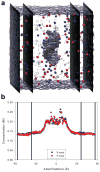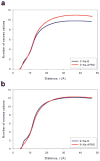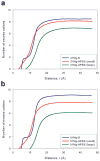Comparison of monovalent and divalent ion distributions around a DNA duplex with molecular dynamics simulation and a Poisson-Boltzmann approach
- PMID: 24443090
- PMCID: PMC4102171
- DOI: 10.1002/bip.22461
Comparison of monovalent and divalent ion distributions around a DNA duplex with molecular dynamics simulation and a Poisson-Boltzmann approach
Abstract
The ion atmosphere created by monovalent (Na(+) ) or divalent (Mg(2+) ) cations surrounding a B-form DNA duplex were examined using atomistic molecular dynamics (MD) simulations and the nonlinear Poisson-Boltzmann (PB) equation. The ion distributions predicted by the two methods were compared using plots of radial and two-dimensional cation concentrations and by calculating the total number of cations and net solution charge surrounding the DNA. Na(+) ion distributions near the DNA were more diffuse in PB calculations than in corresponding MD simulations, with PB calculations predicting lower concentrations near DNA groove sites and phosphate groups and a higher concentration in the region between these locations. Other than this difference, the Na(+) distributions generated by the two methods largely agreed, as both predicted similar locations of high Na(+) concentration and nearly identical values of the number of cations and the net solution charge at all distances from the DNA. In contrast, there was greater disagreement between the two methods for Mg(2+) cation concentration profiles, as both the locations and magnitudes of peaks in Mg(2+) concentration were different. Despite experimental and simulation observations that Mg(2+) typically maintains its first solvation shell when interacting with nucleic acids, modeling Mg(2+) as an unsolvated ion during PB calculations improved the agreement of the Mg(2+) ion atmosphere predicted by the two methods and allowed for values of the number of bound ions and net solution charge surrounding the DNA from PB calculations that approached the values observed in MD simulations.
Keywords: B-form DNA; Poisson-Boltzmann equation; ion atmosphere; molecular dynamics simulation; nucleic acid-cation interactions.
© 2014 Wiley Periodicals, Inc.
Figures
Similar articles
-
Effect of initial ion positions on the interactions of monovalent and divalent ions with a DNA duplex as revealed with atomistic molecular dynamics simulations.J Biomol Struct Dyn. 2013;31(11):1311-23. doi: 10.1080/07391102.2012.732344. Epub 2012 Nov 16. J Biomol Struct Dyn. 2013. PMID: 23153112
-
The ionic atmosphere around A-RNA: Poisson-Boltzmann and molecular dynamics simulations.Biophys J. 2012 Feb 22;102(4):829-38. doi: 10.1016/j.bpj.2011.12.055. Epub 2012 Feb 21. Biophys J. 2012. PMID: 22385854 Free PMC article.
-
Impact of Ion-Mixing Entropy on Orientational Preferences of DNA Helices: FRET Measurements and Computer Simulations.J Phys Chem B. 2023 Oct 19;127(41):8796-8808. doi: 10.1021/acs.jpcb.3c04354. Epub 2023 Oct 10. J Phys Chem B. 2023. PMID: 37815452 Free PMC article.
-
Divalent cations and the electrostatic potential around DNA: Monte Carlo and Poisson-Boltzmann calculations.Biopolymers. 1999 Jun;49(7):575-90. doi: 10.1002/(SICI)1097-0282(199906)49:7<575::AID-BIP4>3.0.CO;2-J. Biopolymers. 1999. PMID: 10226502 Review.
-
Understanding nucleic acid-ion interactions.Annu Rev Biochem. 2014;83:813-41. doi: 10.1146/annurev-biochem-060409-092720. Epub 2014 Mar 5. Annu Rev Biochem. 2014. PMID: 24606136 Free PMC article. Review.
Cited by
-
Hexahydrated Mg2+ Binding and Outer-Shell Dehydration on RNA Surface.Biophys J. 2018 Mar 27;114(6):1274-1284. doi: 10.1016/j.bpj.2018.01.040. Biophys J. 2018. PMID: 29590585 Free PMC article.
-
Structural Comparisons of PEI/DNA and PEI/siRNA Complexes Revealed with Molecular Dynamics Simulations.J Phys Chem B. 2017 Mar 2;121(8):1941-1952. doi: 10.1021/acs.jpcb.6b10775. Epub 2017 Feb 14. J Phys Chem B. 2017. PMID: 28145711 Free PMC article.
-
Predicting RNA-Metal Ion Binding with Ion Dehydration Effects.Biophys J. 2019 Jan 22;116(2):184-195. doi: 10.1016/j.bpj.2018.12.006. Epub 2018 Dec 13. Biophys J. 2019. PMID: 30612712 Free PMC article.
-
Predicting Molecular Crowding Effects in Ion-RNA Interactions.J Phys Chem B. 2016 Sep 1;120(34):8837-44. doi: 10.1021/acs.jpcb.6b05625. Epub 2016 Aug 12. J Phys Chem B. 2016. PMID: 27490487 Free PMC article.
-
RNA Captures More Cations than DNA: Insights from Molecular Dynamics Simulations.J Phys Chem B. 2022 Nov 3;126(43):8646-8654. doi: 10.1021/acs.jpcb.2c04488. Epub 2022 Oct 19. J Phys Chem B. 2022. PMID: 36260822 Free PMC article.
References
Publication types
MeSH terms
Substances
Grants and funding
LinkOut - more resources
Full Text Sources
Other Literature Sources










